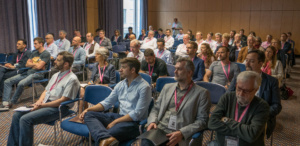Categories
Archives
We are proud to announce the upcoming IPTC Photo Metadata Conference. This year’s event will be held online on Thursday 4th November 2021 as a Zoom webinar, free for anyone to attend, whether you are an IPTC member or not.
We are very happy to be hosting speakers from:
- the Smithsonian Institution, Macmillan Learning, Morey Creative Studios and Level Access speaking about accessibility for images on today’s web
- Adobe and the Content Authenticity Initiative speaking about content authenticity and provenance and the forthcoming C2PA specifications
- Michael Steidl from IPTC’s Photo Metadata Working Group introducing IPTC’s new tools to measure and compare the interoperability of photo metadata tools.
The event will run from 1500 to 1900 UTC, which is:
- 1500 to 1900 in the UK, Ireland and Portugal
- 1600 to 2000 in Central Europe
- 1700 to 2100 in Eastern Europe and Israel
- 1100 to 1500 in US East Coast
- 0800 to 1200 in US West Coast
- 2300 to 0300 in China
- 0200 to 0600 on Australia’s East Coast (sorry about that!)
See more information and register at https://iptc.org/events/photo-metadata-conference-2021/ or simply register using this link.
The webinar will be recorded, and those who register but can’t attend will be sent a link to the video so that they can watch the recording afterwards.
After registering, you will be emailed with a calendar invitation and a Zoom webinar link.
We’re looking forward to seeing you there!
This week IPTC hosted its Spring Meeting. We’re getting used to the online format now and it worked very well once again! We had over 70 attendees this time, from IPTC member organisations and invited guests.
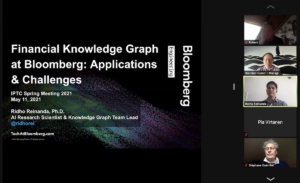
Day One included a focus on accessibility, with Jeanne Spellman of the W3C Silver Task Force giving a preview of the work towards the next version of WCAG, version 3. Jeanne described how the focus is shifting from “all or nothing” compliance to a graded score, with a fairer approach to multiple disabilities rather than the current focus on only a few conditions.
This dovetailed well with Caroline Desrosiers‘ talk about her company (and recently joined IPTC Startup Member) Scribely, which provides image description services to e-commerce and photography companies.
Monday also included a detailed session from Michael Steidl, now co-lead of the Photo Metadata Working Group along with David Riecks, who gave a detailed history lesson on metadata embedded in photos and the various ways that image metadata is used in different image formats. The knowledge came in handy on Wednesday when we looked at the detail of how trust metadata is embedded in images.
Pam Fisher, lead of the Video Metadata Working Group, discussed the WG’s recent work updating the Video Metadata Hub User Guide, looking at new embedded metadata formats, and looking at how to promote the use of Video Metadata Hub as a standardised set of video metadata fields in any formats and tools.
Day Two saw a focus on Knowledge Graphs and Semantic Technology, a growing topic of interest in newsrooms and media organisations around the world. We saw presentations on real-world implementations of knowledge graphs from Stuart Jennings of the BBC; Pia Virtanen of YLE, the Finnish national broadcaster; Ridho Reinanda of Bloomberg, and Manfred Mitterholzer of APA, the Austrian national news agency.
Silver Oliver of consultancy Data Language shared some lessons learned from working with linked data and semantic technologies for 10 years including his work on the BBC Sport Ontology. This led to an update from Paul Kelly on the progress of the IPTC Sports Content Working Group‘s ongoing work on making a semantic web version of our SportsML standard, with help from Silver and others.
Day Three started with updates from the News in JSON Working Group (from WG Lead, Johan Lindgren of TT) looking at work towards ninjs 2.0 including Protocol Buffers compatibility and some new fields for rights management. The NewsML-G2 and News Architecture Working Group update from WG Lead, Dave Compton of Refinitiv discussed some work on making NewsML-G2 easier to understand including a soon-to-be-revealed new version of the NewsML-G2 Generator tool.
After Linda Burman presented the recent work of the IPTC Public Relations Committee, we heard from three trust and credibility projects. WeVerify, presented by Denis Tayssou of AFP, is an EU project creating a toolkit for forensic analysis of website and images that can be used by fact checkers. WordProof, presented by its founder Sebastiaan van der Lans, is a blockchain-based verified time-stamping system that can be used to show when a piece of content was first created. Finally C2PA (the Coalition for Content Authenticity and Provenance) was presented by technical working group lead Leonard Rosenthal of Adobe. C2PA is working on the technical details underpinning the Content Authenticity Initiative, which we have heard about before, so it was great to learn more about the nuts and bolts of how it is planned to work.
Jennifer Parrucci of The New York Times, lead of the NewsCodes Working Group, presented the WG’s latest work, including last week’s update to NewsCodes including Media Topics, and looking into future work around supporting new languages, more integration with Wikidata, and explaining how users of Media Topics can extend the vocabulary to include their own terms. Then Kurt Mathiasen of TV2 Danmark discussed his organisation’s use IPTC Media Topics in their system workflows, and the challenges of their plans to use more industry standards such as IPTC’s News Architecture as a way to join up the metadata that is distributed between third-party systems and currently must be re-keyed or cut-and-pasted from one system to another.
The Spring Meeting ended with a surprise for Stéphane Guérillot, chair of the Standards Committee. He thought he was going to be chairing a meeting but instead we introduced many past IPTC member delegates as guest attendees, and presented a slideshow of some of his history over his amazing 40 year membership of IPTC! We all value and appreciate the work Stéphane has put in to IPTC over his tenure as working group lead, board member and Chair of the Board, Standards Committee Chair, and Treasurer. When Stéphane retires at the end of June, he will be sorely missed, although he is welcome to back any time, because as current Chair Robert Schmidt-Nia announced, the Board has agreed to make Stéphane an Honorary Member of IPTC. Congratulations, Stéphane!
 We are excited to present to IPTC members the full agenda for the IPTC Spring Meeting 2021, taking place online from Monday May 10th to Wednesday May 12th.
We are excited to present to IPTC members the full agenda for the IPTC Spring Meeting 2021, taking place online from Monday May 10th to Wednesday May 12th.
We are honoured to have presentations from IPTC members Adobe, BBC, Agence France-Presse (AFP), The New York Times, Bloomberg, Austria Press Agentur (APA) and new member Scribely, along with guest presentations from the World Wide Web Consortium (W3C), Data Language, TV2 Denmark, and YLE Finland.
Themes include
- metadata for content accessibility;
- knowledge graphs and semantic technologies in news and media; and
- trust and credibility, including a presentation by Leonard Rosenthal of the new Coalition for Content Authenticity and Provenance
Plus we will have all our regular presentations from our Working Groups in NewsML-G2, Photo Metadata, Video Metadata, NewsCodes (including Media Topics), News in JSON and Sports. We will also have sessions for our Standards Committee and PR Committee.
There will also be some time allocated each day to member networking. While we can’t match the networking opportunities of an in-person meeting, we will be using some new tools to make networking more interesting and approachable for members.
We are also planning to hold a special webinar the week before the meeting Introducing knowledge graphs for the media, so we can get straight into the interesting content during the member meeting and not spend time introducing the concepts.
All IPTC member organisations are welcome to attend at no cost.
IPTC members can see more information on the Spring Meeting 2021 page in the IPTC Members-Only Zone.
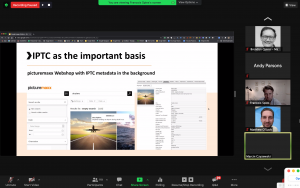
We’re very happy that we can make public some of the video recordings from the recent IPTC Photo Metadata Conference 2020, held on Tuesday 13 October 2020.
Thanks to all who attended – we had over 200 registrations for the webinar.
The videos are embedded below or can be viewed directly on YouTube by following the link above the embedded video.
Introduction
Brendan Quinn, Managing Director of IPTC, opened the day with an introduction to IPTC and an overview of what was to come (10 minutes):
Michael Steidl, Photo Metadata WG lead on IPTC Photo Metadata
Michael Steidl presented on why we should care about photo metadata in his presentation “About IPTC Photo Metadata” (48 minutes including Q&A)
Google’s Licensable Images features
Francois Spies, a Product Manager for Google Images in Mountain View, presented on the Licensable Images features which they developed in consultation with IPTC this year.
After Francois’ presentation, Matthew O’Such, VP SEO for Getty Images and Marcin Czyzewski, CTO and Picturemaxx joined us to share their views on implementing the changes to IPTC Photo Metadata required to power the Google Licensable Images feature. Then we had a Q&A session including Michael, Francois, Matthew and Marcin.
Unfortunately, Google asked us not to make a recording of their presentation or the panel available. However the resources that Francois shared are all available via our Quick Guide to IPTC Photo Metadata and Google Images.
Andy Parsons on the Content Authenticity Initiative
Next up, Andy Parsons (Adobe) introduced the Content Authenticity Initiative (47 minutes including Q&A and a wrap-up of the day from Brendan Quinn):
Thanks again to all our speakers and panellists for their contributions. We’re already looking forward to next year’s event!
Currently next year’s IPTC Photo Metadata Conference is scheduled to be in late May 2021 in Mallorca, Spain in conjunction with the CEPIC Congress 2021. If that proves impractical then we will host another online event.
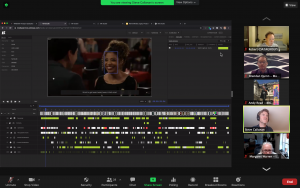
We had a great IPTC Member Meeting last week, our second online event. We’re getting used to online events now!
After introductions and a get-to-know-your-fellow-members session, Dave Compton of Refinitiv presented the NewsML-G2 Working Group‘s report. We didn’t have a new version of NewsML-G2 this time but we are doing work on making NewsML-G2 easier to understand and to use. We have been working on a NewsML-G2 Generator (soon to be launched), NewsML-G2 unit tests and a Python module. Some proposals for additions to NewsML-G2 were also discussed.
Brendan Quinn, IPTC Managing Director then hosted a re-introduction to semantic web technology: RDF, SPARQL, schema.org and how they relate to GraphQL, knowledge graphs and other buzzwords in 2020’s world of data. This proved to be a useful background and refresher for many of the following sessions over the next three days that touched upon semantic technology in almost every presentation!
Paul Kelly, individual member and group lead, presented the Sports Content Working Group‘s report highlighting the work that the group is pursuing on looking at a more semantically rich successor to SportsML.
Jennifer Parrucci of The New York Times presented the NewsCodes Working Group report. The focus since the last meeting was on a new batch of Media Topics terms, refreshing some labels and definitions, and adding more translations – we are now up to 11 languages in the Media Topics vocabulary! We have also updated the Genres vocabulary and launched the Trust Indicators CV.
Still on metadata and controlled vocabularies, we hosted a presentation and discussion session about Named Entities for News, including presentations by IPTC members Christoffer Krona from iMatrics, Jennifer Parrucci from The New York Times and Jeremy Tarling from BBC showing their organisations’ approach to managing metadata for named entities such as people, places and organisations. We had an interesting discussion about how IPTC can help the industry to move forward in managing named entities. Look out for more information from us soon!

On Tuesday, we started with Michael Steidl‘s Photo Metadata Working Group presentation, including a report on how the Google Licensable Images work has been received. Pam Fisher, lead of the Video Metadata Working Group then presented ongoing work towards a new user guide for video metadata, based on use cases and scenarios so we can make video metadata more approachable for people in different parts of the media industry.
Johan Lindgren of TT Nyhetsbyrån presented the work of the News in JSON Working Group, including discussions of work towards a ninjs 2.0, looking at how ninjs can map to binary serialisation formats such as Protocol Buffers and Avro, and support for machine-readable rights in ninjs documents.
The second half of Tuesday was filled by the IPTC Photo Metadata Conference 2020 – see our separate news post about that event!
Wednesday morning was dedicated to important IPTC internal business, including the IPTC 2020 Annual General Meeting, where we re-elected the current board including Robert Schmidt-Nia of DATAGROUP as IPTC Chair. Linda Burman, individual member and Chair of the PR Committee,
We also held the Autumn 2020 IPTC Standards Committee Meeting, chaired by Stéphane Guérillot of Agence France-Presse, where we discussed our ongoing project to “make IPTC standards more usable”. If you have any ideas about how we can make our work more usable or more accessible, please get in touch!
We ended the day with presentations from Laurent Le Meur of EDRLab, Steve Callanan of WireWax presenting their video analysis and manipulation tools, and Andy Read of the BBC speaking about their implementation of the GRID open source image management system.
IPTC members can find PDFs of all presentation files on the members-only event page.
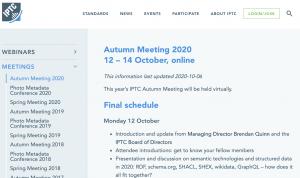 The IPTC Autumn Meeting 2020 will take place next week, from Monday 12 October to Wednesday 14 October. The meeting will be held online using the Zoom platform, as we did for the IPTC Spring Meeting in May.
The IPTC Autumn Meeting 2020 will take place next week, from Monday 12 October to Wednesday 14 October. The meeting will be held online using the Zoom platform, as we did for the IPTC Spring Meeting in May.
Over 30 IPTC member organisations will be represented, with more still finalising their attendance.
Presentations will range from Working Group updates and our 2020 Annual General Meeting to presentations from invited startups, discussions on IPTC participation in industry projects, and exciting presentations from members on relevant projects within their companies.
The IPTC Photo Metadata Conference 2020 is “co-located” with the IPTC Autumn Meeting – so we will be moving from the member meeting to the Photo Metadata Conference on the Tuesday afternoon.
Attendance is free for IPTC members. If you are not already registered, please go to the Members-Only event page to register.
 We are very happy to announce that this year’s IPTC Photo Metadata Conference will be conducted fully online, and for the first time ever, is free for all to attend.
We are very happy to announce that this year’s IPTC Photo Metadata Conference will be conducted fully online, and for the first time ever, is free for all to attend.
This year’s conference takes place on Tuesday October 13, 2020 from 15:00 – 18:00 UTC time (see times in other timezones below).
We have some very special guests for this year’s conference:
 Michael Steidl, Lead of the IPTC Photo Metadata Working Group, will introduce IPTC Photo Metadata, and discuss recent developments, and what we see in the future of photo metadata.
Michael Steidl, Lead of the IPTC Photo Metadata Working Group, will introduce IPTC Photo Metadata, and discuss recent developments, and what we see in the future of photo metadata.
 Francois Spies, Product Manager, Google Images will present Google’s recent work on the “Licensable Images” project, which adds a “licensable” badge to images in Google search results, and links from the image preview panel in search results pages directly back to a place where users can obtain a licence to re-use the image.
Francois Spies, Product Manager, Google Images will present Google’s recent work on the “Licensable Images” project, which adds a “licensable” badge to images in Google search results, and links from the image preview panel in search results pages directly back to a place where users can obtain a licence to re-use the image.
 Andy Parsons, Director of Content Authenticity Initiative, Adobe will present the Content Authenticity Initiative, which is “designing components and drafting standards specifications for a simple, extensible and distributed media provenance solution.”
Andy Parsons, Director of Content Authenticity Initiative, Adobe will present the Content Authenticity Initiative, which is “designing components and drafting standards specifications for a simple, extensible and distributed media provenance solution.”
How will the Content Authenticity Initiative work? What work has been done so far and what still needs to be done? How can you help?
Please register here via Zoom – it’s free!
The IPTC Photo Metadata Conference has been held in conjunction with the CEPIC Congress for many years. The 2020 CEPIC Congress has been postponed to 19 to 21 May 2021, but with so much going on in the world of image metadata, we didn’t want to miss out on the opportunity, so we are holding a virtual event this year. We look forward to joining CEPIC again next year, hopefully in Mallorca in May 2021.
IPTC Photo Metadata Conference 2020: times around the world
- UTC / GMT: Weds 13 October, 1500 – 1800 UTC
- London: Weds 13 October, 1600 – 1900 BST
- Paris, Berlin, Amsterdam, Vienna: Weds 13 October, 1700 – 2000 CEST
- Helsinki, Dubai, Tallinn: Weds 13 October, 1800 – 2100 EEST
- New York, Toronto: Weds 13 October, 1100 – 1400 EDT
- Beijing, Shanghai: Weds 13 October, 2300 – Thurs 14 October, 0200
When you register for the webinar on Zoom you will be sent a calendar invitation so you can make sure you attend at the right time!
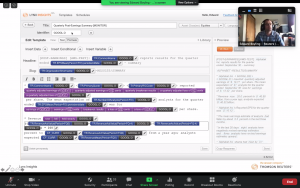
Last week IPTC did something we had never tried before: we ran a complete three-day member meeting virtually, using videoconferencing, which worked very well! Thanks to all our participants and presenters.
Spread over three days, over 50 attendees from the majority of IPTC member organisations across 16 countries heard over 20 presentations from IPTC Working Groups, IPTC member organisations and invited speakers on topics from AI-generated stock photography to tracking entities in news stories. The culmination of the event was the approval of new versions of ninjs, NewsML-G2 and Video Metadata Hub, and the (re-)election of Robert Schmidt-Nia as Chair of IPTC.
Monday: Photo Metadata, Sport and Web Publications
Monday set the tone with an introduction from IPTC Managing Director Brendan Quinn, and introductions from all attendees. Michael Steidl gave the first Working Group update as Lead of the Photo Metadata Working Group, covering the group’s wide-ranging work over the past six months including releasing the Photo Metadata Standard 2019.1 including Image Regions, plus partnership projects with Google on exposing embedded IPTC Photo Metadata fields in search results, and emerging work with camera industry association CIPA and schema.org.

Laurent Le Meur, previous IPTC board member and currently CTO at EDRLab, gave a thought-provoking presentation on W3C Web Publications spec and how it might apply to the news publishing industry. Paul Kelly, lead of the Sports Content Working Group presented his group’s investigations into semantic modelling for sports content, looking at existing sports models and current projects investigating schema.org and semantic / linked-data modelling of sports information, which will feed in to an upcoming version of SportsML.
Tuesday: NewsML-G2, ninjs, Robojournalism, AI, Blockchain, Trust and Video
Tuesday was a busy day: we started with Dave Compton from Refinitiv, lead of the NewsML-G2 Working Group, presenting the group’s latest work including their proposal for NewsML-G2 2.29. Johan Lindgren of TT and lead of the News in JSON Working Group presented a proposal for ninjs 1.3, including many updates suggested by users and the community.
Ed Boyling of Thomson Reuters demonstrated a tool called Lynx Insights that is used by TR to generate news stories based on a rich set of rules defined by journalists. After a rule is created, an incoming news event (such as a company publishing a set of financial results) can automatically be converted to a readable story published on the wire within seconds.
Tao Chen of 500px (part of IPTC member Visual China Group) and lead of the AI Expert Group presented their latest work on AI for images, including automatic quality detection, face anonymisation, subjective feature detection (photos about “happiness” or “romance”), moving from simple face detection to age, gender and celebrity detection, automatic cutouts and more.
Angelo Marrara of ANSA and some project colleagues from EY presented their work on ANSACheck, a way of ensuring that content matches what the agency originally published using blockchain technology. The project has launched and you can see the tool embedded on ANSA’s pages.
Brendan Quinn presented IPTC’s latest work on trust and credibility in the news, including the IPTC Trust and Credibility Guidelines document draft that was published recently.
Finally, Pam Fisher of the Video Metadata Working Group presented the group’s proposal for Video Metadata Hub version 1.3, an update to clarify and simplify some points and take on some suggestions from the community.
Wednesday: NewsCodes translations, Entities, Standards Committee and IPTC Election
Wednesday started off with Jennifer Parrucci of New York Times, lead of IPTC’s NewsCodes Working Group, presenting the group’s work since the last meeting, announcing translations of the core Media Topics controlled vocabulary into Danish, Simplified Chinese and Norwegian. We now publish Media Topics in 11 languages!

Christoffer Nilsson of new IPTC member iMatrics and Joacim Ståhl of Elysium AI (part of TT) both gave presentations on their work on extracting entities (people, places, organisations and objects) from news content, and we discussed the possibility of working as a group on an industry-wide “news entities” database.
The Spring 2020 IPTC Standards Committee Meeting was led by Stéphane Guérrilot of AFP, Chair of the Standards Committee. The first part of the meeting was a wide-ranging discussion on “how to make IPTC standards easier to use”, which will lead to some interesting projects in the next few months on documentation, marketing materials, and open source software. The second part of the meeting was the formal IPTC member vote on the proposed new standard versions: we are pleased to say that ninjs 1.3, NewsML-G2 2.29 and Video Metadata Hub 1.3 were all approved!
Finally we held a General Meeting of IPTC voting Members, during which Robert Schmidt-Nia of DATAGROUP Consulting Services was elected as IPTC Chair. We also voted through a change to IPTC’s official Articles of Association, introducing a new membership category. More on this in coming weeks!
Thanks again to everyone who made our first fully virtual member meeting such a a great success!
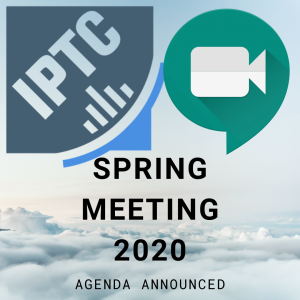 The agenda for the IPTC Spring Meeting (May 11 – 13 2020) has been announced, featuring a focus on news automation.
The agenda for the IPTC Spring Meeting (May 11 – 13 2020) has been announced, featuring a focus on news automation.
Brendan Quinn, Managing Director of IPTC, says “we are very excited to host the first virtual meeting of IPTC. All members are encouraged to attend via Zoom video conferencing, and we hope that many members who find it difficult to travel to the face-to-face meetings will take the opportunity to attend the online meeting.”
Presentations and topics for discussion will include:
- Ed Boyling of Thomson Reuters will present their Lynx Insight system which blends human and machine insights for news creation. Tao Chen of 500px / Visual China Group, Lead of IPTC’s AI Expert Group will present on 500px’s work on AI stock photos. Claudia Quinonez of Bloomberg will give a presentation on “Deep Data-driven Stories”
- Presentations and discussion on metadata entities with Fredrik Lundberg of iMatrics and Joacim Ståhl from TT
- Updates from IPTC Working Group leads on the latest proposed updates to ninjs, NewsML-G2 and Video Metadata Hub, and voting on the proposals by the IPTC Standards Committee
- The latest work of the Photo Metadata Working Group, including recent work with Google on surfacing embedded copyright and licensing metadata in Google Image Search results
- A presentation from W3C Web Publications working group on the Web Publications standard
- Updates on IPTC’s recent work on the Google News Initiative project C-POP and on our work on expressing trust and credibility indicators in news content
The meeting will be held on the originally planned days — Monday 11th through to Wednesday 13th May 2020 — but will take place over five hours each day so attendees still have some time to do other work if necessary.
Attendance is free for all IPTC members. Members should sign up at the members-only registration page to be sent an invitation link.
There is still time to join IPTC to attend the meeting. If you are interested in joining IPTC, please see the join IPTC page.
The IPTC Board was looking forward to having a meeting in Tallinn, Estonia, and hopes that we will be able to have an in-person meeting in Tallinn in coming years.
We were very much looking forward to our IPTC 2020 Spring Meeting in Tallinn, Estonia, beautiful city on the Baltic Sea and home city of Brendan Quinn, Managing Director of IPTC. But unfortunately, circumstances mean that we can not hold the meeting in person this time.
Instead we are looking forward to hosting IPTC’s first ever virtual Spring Meeting!
We will be going ahead with the dates that we had planned: Monday May 11 to Wednesday May 13, but rather than having all-day sessions, we will be having sessions from 13.00 to 18.00 UTC on each day.
This meeting will include:
- The usual updates from our working groups including the Photo Metadata Working Group, Video Metadata Working Group, News Architecture Working Group, NewsCodes Working Group, News in JSON Working Group, Sports Content Working Group
- Speakers from IPTC Members such as Reuters, New York Times, Bloomberg and TT on related projects in their newsrooms
- Invited guest speakers from companies related to our standards and key topics
- The special topic focus for this meeting is “robojournalism” and automated media generation
- Because we know how attendees love the networking and interaction sides of our face-to-face meetings, we will have several sessions that aim to let attendees discuss issues with each other and encourage participation in side rooms and through other channels such as our Slack community.
All IPTC Members are invited to attend. For this virtual meeting, there is no cost for IPTC members to attend.
IPTC Member Delegates should look out for an email from Brendan Quinn containing the registration link, or see the event page on the IPTC Members-Only Zone for the registration link.
